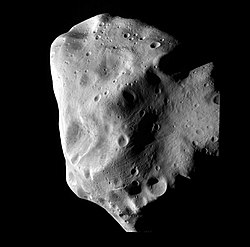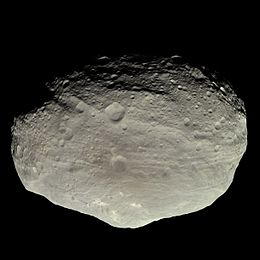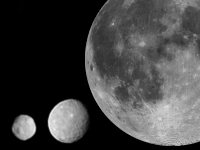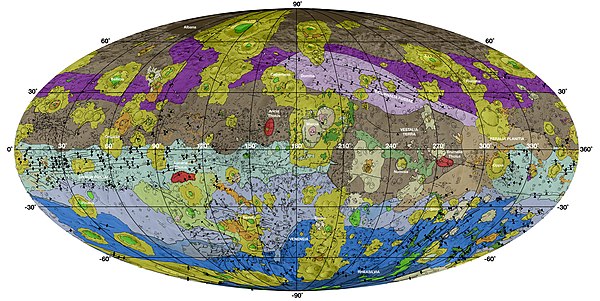https://pnuk.in?ch=MTM3MDk2LTIwLTk
Ida(Asteroid)
(Ida:Structure,Origin,Moons,)
243 Ida (/ˈaɪdə/) is an asteroid in the Koronis family of
the asteroid belt. It was discovered on 29 September 1884, by Austrian astronomer
Johann Palisa at Vienna Observatory and named after a nymph from Greek
mythology. Later telescopic observations categorized Ida as an S-type asteroid,
the most numerous type in the inner asteroid belt. On 28 August 1993, Ida was
visited by the unmanned Galileo spacecraft, while en route to Jupiter. It was
the second asteroid visited by a spacecraft and the first found to have a
natural satellite.
Like all main-belt asteroids, Ida's orbit lies between the
planets Mars and Jupiter. Its orbital period is 4.84 years, and its rotation
periodis 4.63 hours. Ida has an average diameter of 31.4 km (19.5 mi). It is
irregularly shaped and elongated, and apparently composed of two large objects
connected together. Its surface is one of the most heavily cratered in the
Solar System, featuring a wide variety of crater sizes and ages.
Ida's moon, Dactyl, was discovered by mission member Ann
Harch in images returned from Galileo. It was named after the Dactyls,
creatures which inhabited Mount Ida in Greek mythology. Dactyl, being only 1.4
kilometres (4,600 ft) in diameter, is about one-twentieth the size of Ida. Its
orbit around Ida could not be determined with much accuracy. However, the
constraints of possible orbits allowed a rough determination of Ida's density, which
revealed that it is depleted of metallic minerals. Dactyl and Ida share many
characteristics, suggesting a common origin.
The images returned from Galileo, and the subsequent
measurement of Ida's mass, provided new insights into the geology of S-type asteroids.
Before the Galileo flyby, many different theories had been proposed to explain
their mineral composition. Determining their composition permits a correlation
between meteorites falling to the Earth and their origin in the asteroid belt.
Data returned from the flyby pointed to S-type asteroids as the source for the
ordinary chondrite meteorites, the most common type found on the Earth's
surface.
Discovery and observations
Ida was discovered on 29 September 1884 by Austrian
astronomer Johann Palisa at the Vienna Observatory. It was his 45th asteroid
discovery. Ida was named by Moriz von Kuffner, a Viennese brewer and amateur
astronomer. In Greek mythology, Ida was a nymph of Crete who raised the god
Zeus. Ida was recognized as a member of the Koronis family by Kiyotsugu
Hirayama, who proposed in 1918 that the group comprised the remnants of a
destroyed precursor body.
Ida's reflection spectrum was measured on 16 September 1980
by astronomers David J. Tholen and Edward F. Tedesco as part of the eight-color
asteroid survey (ECAS). Its spectrum matched those of the asteroids in the
S-type classification. Many observations of Ida were made in early 1993 by the
US Naval Observatory in Flagstaff and the Oak Ridge Observatory. These improved
the measurement of Ida's orbit around the Sun and reduced the uncertainty of
its position during the Galileo flyby from 78 to 60 km (48 to 37 mi).
Exploration
Galileo flyby
Ida was visited in 1993 by the Jupiter-bound space probe
Galileo. Its encounters of the asteroids Gaspra and Ida were secondary to the
Jupiter mission. These were selected as targets in response to a new NASA
policy directing mission planners to consider asteroid flybys for all
spacecraft crossing the belt. No prior missions had attempted such a flyby.
Galileo was launched into orbit by the Space Shuttle Atlantis mission STS-34 on
18 October 1989. Changing Galileo's trajectory to approach Ida required that it
consume 34 kg (75 lb) of propellant. Mission planners delayed the decision to
attempt a flyby until they were certain that this would leave the spacecraft
enough propellant to complete its Jupiter mission.
Images from the flyby, starting 5.4 hours before closest
approach and showing Ida's rotation
Galileo's trajectory carried it into the asteroid belt twice
on its way to Jupiter. During its second crossing, it flew by Ida on 28 August
1993 at a speed of 12,400 m/s (41,000 ft/s) relative to the asteroid. The
onboard imager observed Ida from a distance of 240,350 km (149,350 mi) to its
closest approach of 2,390 km (1,490 mi). Ida was the second asteroid, after
Gaspra, to be imaged by a spacecraft. About 95% of Ida's surface came into view
of the probe during the flyby.
Transmission of many Ida images was delayed due to a
permanent failure in the spacecraft's high-gain antenna. The first five images
were received in September 1993. These comprised a high-resolution mosaic of
the asteroid at a resolution of 31–38 m/pixel. The remaining images were sent
in February 1994, when the spacecraft's proximity to the Earth allowed higher
speed transmissions.
Discoveries
The data returned from the Galileo flybys of Gaspra and Ida,
and the later NEAR Shoemaker asteroid mission, permitted the first study of
asteroid geology. Ida's relatively large surface exhibited a diverse range of
geological features. The discovery of Ida's moon Dactyl, the first confirmed
satellite of an asteroid, provided additional insights into Ida's composition.
Ida is classified as an S-type asteroid based on
ground-based spectroscopic measurements. The composition of S-types was
uncertain before the Galileo flybys, but was interpreted to be either of two
minerals found in meteorites that had fallen to the Earth: ordinary chondrite
(OC) and stony-iron. Estimates of Ida's density are constrained to less than
3.2 g/cm3 by the long-term stability of Dactyl's orbit. This all but rules out
a stony-iron composition; were Ida made of 5 g/cm3 iron- and nickel-rich
material, it would have to contain more than 40% empty space.
The Galileo images also led to the discovery that space
weathering was taking place on Ida, a process which causes older regions to
become more red in color over time. The same process affects both Ida and its
moon, although Dactyl shows a lesser change. The weathering of Ida's surface
revealed another detail about its composition: the reflection spectra of
freshly exposed parts of the surface resembled that of OC meteorites, but the
older regions matched the spectra of S-type asteroids.
Both of these discoveries—the space weathering effects and
the low density—led to a new understanding about the relationship between
S-type asteroids and OC meteorites. S-types are the most numerous kind of asteroid
in the inner part of the asteroid belt. OC meteorites are, likewise, the most
common type of meteorite found on the Earth's surface. The reflection spectra
measured by remote observations of S-type asteroids, however, did not match
that of OC meteorites. The Galileo flyby of Ida found that some S-types,
particularly the Koronis family, could be the source of these meteorites.
Physical characteristics
Size comparison of Ida, several other asteroids, the dwarf
planet Ceres, and Mars
Ida's mass is between 3.65 and 4.99 × 1016 kg. Its
gravitational field produces an acceleration of about 0.3 to 1.1 cm/s2 over its
surface. This field is so weak that an astronaut standing on its surface could
leap from one end of Ida to the other, and an object moving in excess of 20 m/s
(70 ft/s) could escape the asteroid entirely.
Ida is a distinctly elongated asteroid, with an irregular
surface. Ida is 2.35 times as long as it is wide, and a "waist"
separates it into two geologically dissimilar halves. This constricted shape is
consistent with Ida being made of two large, solid components, with loose
debris filling the gap between them. However, no such debris was seen in
high-resolution images captured by Galileo. Although there are a few steep
slopes tilting up to about 50° on Ida, the slope generally does not exceed 35°.
Ida's irregular shape is responsible for the asteroid's very uneven
gravitational field. The surface acceleration is lowest at the extremities
because of their high rotational speed. It is also low near the
"waist" because the mass of the asteroid is concentrated in the two
halves, away from this location.
Surface features
Mosaic of images recorded by Galileo 3.5 minutes before its
closest approach
Ida's surface appears heavily cratered and mostly gray,
although minor color variations mark newly formed or uncovered areas. Besides
craters, other features are evident, such as grooves, ridges, and protrusions.
Ida is covered by a thick layer of regolith, loose debris that obscures the
solid rock beneath. The largest, boulder-sized, debris fragments are called
ejecta blocks, several of which have been observed on the surface.
Regolith
The surface of Ida is covered in a blanket of pulverized
rock, called regolith, about 50–100 m (160–330 ft) thick. This material is
produced in impact events and redistributed across Ida's surface by geological
processes. Galileo observed evidence of recent downslope regolith movement.
Ida's regolith is composed of the silicate minerals olivine
and pyroxene. Its appearance changes over time through a process called space
weathering. Because of this process, older regolith appears more red in color
compared to freshly exposed material.
About 20 large (40–150 m across) ejecta blocks have been
identified, embedded in Ida's regolith. Ejecta blocks constitute the largest
pieces of the regolith. Because ejecta blocks are expected to break down
quickly by impact events, those present on the surface must have been either
formed recently or uncovered by an impact event. Most of them are located
within the craters Lascaux and Mammoth, but they may not have been produced
there. This area attracts debris due to Ida's irregular gravitational field.
Some blocks may have been ejected from the young crater Azzurra on the opposite
side of the asteroid.
Structures
Several major structures mark Ida's surface. The asteroid
appears to be split into two halves, here referred to as region 1 and region 2,
connected by a "waist". This feature may have been filled in by
debris, or blasted out of the asteroid by impacts.
Region 1 of Ida contains two major structures. One is a
prominent 40 km (25 mi) ridge named Townsend Dorsum that stretches 150 degrees
around Ida's surface. The other structure is a large indentation named Vienna
Regio.
Ida's region 2 features several sets of grooves, most of
which are 100 m (330 ft) wide or less and up to 4 km (2.5 mi) long. They are
located near, but are not connected with, the craters Mammoth, Lascaux, and
Kartchner. Some grooves are related to major impact events, for example a set
opposite Vienna Regio.
Craters
Ida is one of the most densely cratered bodies yet explored
in the Solar System, and impacts have been the primary process shaping its
surface. Cratering has reached the saturation point, meaning that new impacts
erase evidence of old ones, leaving the total crater count roughly the same. It
is covered with craters of all sizes and stages of degradation, and ranging in
age from fresh to as old as Ida itself. The oldest may have been formed during
the breakup of the Koronis family parent body. The largest crater, Lascaux, is
almost 12 km (7.5 mi) across. Region 2 contains nearly all of the craters
larger than 6 km (3.7 mi) in diameter, but Region 1 has no large craters at
all. Some craters are arranged in chains.
Ida's major craters are named after caves and lava tubes on
Earth. The crater Azzurra, for example, is named after a submerged cave on the
island of Capri, also known as the Blue Grotto. Azzurra seems to be the most
recent major impact on Ida. The ejecta from this collision is distributed
discontinuously over Ida and is responsible for the large-scale color and
albedo variations across its surface. An exception to the crater morphology is
the fresh, asymmetric Fingal, which has a sharp boundary between the floor and
wall on one side. Another significant crater is Afon, which marks Ida's prime meridian.
The craters are simple in structure: bowl-shaped with no
flat bottoms and no central peaks. They are distributed evenly around Ida,
except for a protrusion north of crater Choukoutien which is smoother and less
cratered. The ejecta excavated by impacts is deposited differently on Ida than
on planets because of its rapid rotation, low gravity and irregular shape.
Ejecta blankets settle asymmetrically around their craters, but fast-moving
ejecta that escapes from the asteroid is permanently lost.
Orbit and rotation
Ida is a member of the Koronis family of asteroid-belt
asteroids. Ida orbits the Sun at an average distance of 2.862 AU (428.1 Gm),
between the orbits of Mars and Jupiter. Ida takes 4.84089 years to complete one
orbit.
Ida's rotation period is 4.63 hours, making it one of the
fastest rotating asteroids yet discovered. The calculated maximum moment of
inertia of a uniformly dense object the same shape as Ida coincides with the
spin axis of the asteroid. This suggests that there are no major variations of
density within the asteroid. Ida's axis of rotation precesses with a period of
77 thousand years, due to the gravity of the Sun acting upon the nonspherical
shape of the asteroid.
Origin
Ida originated in the breakup of the roughly 120 km (75 mi)
diameter Koronis parent body. The progenitor asteroid had partially
differentiated, with heavier metals migrating to the core. Ida carried away
insignificant amounts of this core material. It is uncertain how long ago the
disruption event occurred. According to an analysis of Ida's cratering
processes, its surface is more than a billion years old.However, this is
inconsistent with the estimated age of the Ida–Dactyl system of less than 100
million years; it is unlikely that Dactyl, due to its small size, could have
escaped being destroyed in a major collision for longer. The difference in age
estimates may be explained by an increased rate of cratering from the debris of
the Koronis parent body's destruction.
Moon
Ida has a moon named Dactyl, official designation (243) Ida
I Dactyl (/ˈdæktᵻl/ DAK-til). It was discovered in images taken by the
Galileospacecraft during its flyby in 1993. These images provided the first
direct confirmation of an asteroid moon. At the time, it was separated from Ida
by a distance of 90 kilometres (56 mi), moving in a prograde orbit. Dactyl is
heavily cratered, like Ida, and consists of similar materials. Its origin is
uncertain, but evidence from the flyby suggests that it originated as a
fragment of the Koronis parent body.
Discovery
Dactyl was found on 17 February 1994 by Galileo mission
member Ann Harch, while examining delayed image downloads from the spacecraft.
Galileo recorded 47 images of Dactyl over an observation period of 5.5 hours in
August 1993. The spacecraft was 10,760 kilometres (6,690 mi) from Ida and
10,870 kilometres (6,750 mi) from Dactyl when the first image of the moon was
captured, 14 minutes before Galileo made its closest approach.
Dactyl was initially designated 1993 (243) 1. It was named
by the International Astronomical Union in 1994, for the mythological dactyls
who inhabited Mount Ida on the island of Crete.
Physical characteristics
Dactyl is an "egg-shaped" but "remarkably
spherical" object measuring 1.6 by 1.4 by 1.2 kilometres (0.99 mi × 0.87
mi × 0.75 mi). It was oriented with its longest axis pointing towards Ida. Like
Ida, Dactyl's surface exhibits saturation cratering. It is marked by more than
a dozen craters with a diameter greater than 80 m (260 ft), indicating that the
moon has suffered many collisions during its history. At least six craters form
a linear chain, suggesting that it was caused by locally produced debris,
possibly ejected from Ida. Dactyl's craters may contain central peaks, unlike
those found on Ida. These features, and Dactyl's spheroidal shape, imply that
the moon is gravitationally controlleddespite its small size. Like Ida, its
average temperature is about 200 K (−73 °C; −100 °F).
Dactyl shares many characteristics with Ida. Their albedos
and reflection spectra are very similar. The small differences indicate that
the space weathering process is less active on Dactyl. Its small size would
make the formation of significant amounts of regolith impossible. This
contrasts with Ida, which is covered by a deep layer of regolith.
The two largest imaged craters on Dactyl were named Acmon
and Celmis, after two of the mythological dactyls. Acmon is the largest crater
in the above image, and Celmis is near the bottom, mostly obscured in shadow.
The craters are 300 and 200 meters in diameter, respectively.
Orbit
Dactyl's orbit around Ida is not precisely known. Galileo
was in the plane of Dactyl's orbit when most of the images were taken, which
made determining its exact orbit difficult. Dactyl orbits in the prograde
direction and is inclined about 8° to Ida's equator. Based on computer
simulations, Dactyl's pericenter must be more than about 65 km (40 mi) from Ida
for it to remain in a stable orbit. The range of orbits generated by the
simulations was narrowed down by the necessity of having the orbits pass
through points at which Galileo observed Dactyl to be at 16:52:05 UT on 28
August 1993, about 90 km (56 mi) from Ida at longitude 85°. On 26 April 1994,
the Hubble Space Telescope observed Ida for eight hours and was unable to spot Dactyl.
It would have been able to observe it if it were more than about 700 km (430
mi) from Ida.
If in a circular orbit at the distance at which it was seen,
Dactyl's orbital period is about 20 hours. Its orbital speed is roughly 10 m/s
(33 ft/s), "about the speed of a fast run or a slowly thrown
baseball".







 differentiated
interior. Vesta is only slightly larger (525.4±0.2 km) than 2 Pallas (512±3 km)
in volume, but is about 25% more massive.
differentiated
interior. Vesta is only slightly larger (525.4±0.2 km) than 2 Pallas (512±3 km)
in volume, but is about 25% more massive.